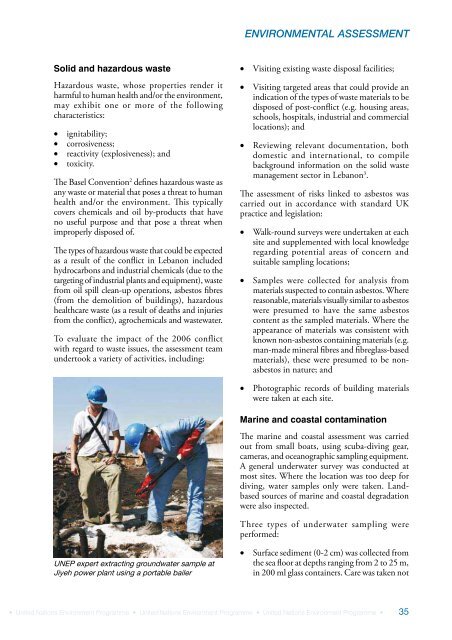Lebanon Post-Conflict Environmental Assessment - UNEP
Lebanon Post-Conflict Environmental Assessment - UNEP
Lebanon Post-Conflict Environmental Assessment - UNEP
Create successful ePaper yourself
Turn your PDF publications into a flip-book with our unique Google optimized e-Paper software.
ENVIRONMENTAL ASSESSMENTSolid and hazardous wasteHazardous waste, whose properties render itharmful to human health and/or the environment,may exhibit one or more of the followingcharacteristics: ignitability; corrosiveness; reactivity (explosiveness); and toxicity.The Basel Convention 2 defines hazardous waste asany waste or material that poses a threat to humanhealth and/or the environment. This typicallycovers chemicals and oil by-products that haveno useful purpose and that pose a threat whenimproperly disposed of.The types of hazardous waste that could be expectedas a result of the conflict in <strong>Lebanon</strong> includedhydrocarbons and industrial chemicals (due to thetargeting of industrial plants and equipment), wastefrom oil spill clean-up operations, asbestos fibres(from the demolition of buildings), hazardoushealthcare waste (as a result of deaths and injuriesfrom the conflict), agrochemicals and wastewater.To evaluate the impact of the 2006 conflictwith regard to waste issues, the assessment teamundertook a variety of activities, including: Visiting existing waste disposal facilities; Visiting targeted areas that could provide anindication of the types of waste materials to bedisposed of post-conflict (e.g. housing areas,schools, hospitals, industrial and commerciallocations); and Reviewing relevant documentation, bothdomestic and international, to compilebackground information on the solid wastemanagement sector in <strong>Lebanon</strong> 3 .The assessment of risks linked to asbestos wascarried out in accordance with standard UKpractice and legislation: Walk-round surveys were undertaken at eachsite and supplemented with local knowledgeregarding potential areas of concern andsuitable sampling locations; Samples were collected for analysis frommaterials suspected to contain asbestos. Wherereasonable, materials visually similar to asbestoswere presumed to have the same asbestoscontent as the sampled materials. Where theappearance of materials was consistent withknown non-asbestos containing materials (e.g.man-made mineral fibres and fibreglass-basedmaterials), these were presumed to be nonasbestosin nature; and Photographic records of building materialswere taken at each site.Marine and coastal contaminationThe marine and coastal assessment was carriedout from small boats, using scuba-diving gear,cameras, and oceanographic sampling equipment.A general underwater survey was conducted atmost sites. Where the location was too deep fordiving, water samples only were taken. Landbasedsources of marine and coastal degradationwere also inspected.Three types of underwater sampling wereperformed:<strong>UNEP</strong> expert extracting groundwater sample atJiyeh power plant using a portable bailer Surface sediment (0-2 cm) was collected fromthe sea floor at depths ranging from 2 to 25 m,in 200 ml glass containers. Care was taken not• United Nations Environment Programme • United Nations Environment Programme • United Nations Environment Programme •35
















